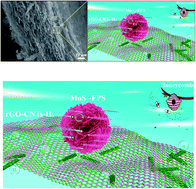Structure-designed synthesis of 3D MoS2 anchored on ionic liquid modified rGO–CNTs inspired by a honeycomb for excellent lithium storage†
Abstract
MoS2 is currently under intensive research as a potential candidate for energy storage applications because of its high theoretical capacity. However, unmodified MoS2 suffers from inferior rate capability and poor long-term cycling stability. Inspired by a hornet making a nest and the favorable shape and structural strength of a honeycomb, a composite with a three-dimensional highly porous sandwiched honeycomb structure has been successfully prepared for the first time. Its novel structure originates from anchoring self-assembled flower-like porous MoS2 slices (MoS2-FPSs) on layer-by-layer reduced graphene oxide (rGO)–carbon nanotubes (CNTs) with the assistance of an ionic liquid (IL). The MoS2 ultrathin nanosheets are self-assembled to form MoS2-FPSs and then co-assembled with rGO and CNTs to generate a hierarchical porous structure. By virtue of this novel superstructure, the electrode demonstrates remarkable electrochemical properties with a high initial capacity (1456 mA h g−1) and an enhanced high rate capability (712 mA h g−1 at 5 A g−1), as well as one of the best long-term cycling stabilities with a capacity decay as low as 0.0075% per cycle (745 mA h g−1 at 5 A g−1 after 1000 cycles), confirming its potential application in high-performance lithium-ion batteries.



 Please wait while we load your content...
Please wait while we load your content...